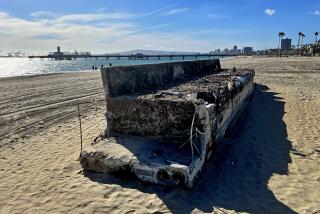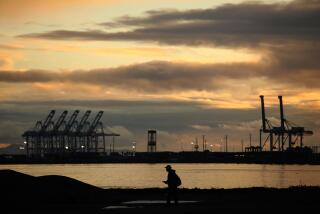Long Beach cleans up polluted waters
The waters off Long Beach — long among the most contaminated in the state — have improved dramatically in the last year, according to a new report that gives the city’s beaches their highest water quality ratings in more than a decade.
All the beaches in the city earned grades of A or B in the environmental group Heal the Bay’s End of Summer Beach Report Card, released Tuesday.
It’s a significant turnaround for Long Beach, which sits at the outlet of the Los Angeles River, a major conduit for polluted urban runoff. Last summer, 73% of the beaches in Los Angeles County’s second-largest city earned A or B grades.
“The magnitude of the improvement caught us off guard,” said Heal the Bay President Mark Gold. Staffers at the Santa Monica-based water quality group expected the test results to inch upward, he said, “but we never expected for them to have a perfect report card.”
Statewide, 92% of California beaches earned A or B grades over the summer, the same as last year, according to the report.
But the picture was not rosy at some Southern California beaches.
Cabrillo Beach in San Pedro earned an F for the eighth consecutive summer despite millions of dollars spent on municipal projects to improve water quality.
Also flunking were a number of popular beaches in Malibu, including Surfrider Beach, Malibu Pier, Solstice Canyon at Dan Blocker County Beach, Carbon Beach at Sweetwater Canyon and Topanga State Beach.
The annual report by Heal the Bay evaluated hundreds of beaches in California, Oregon and Washington from Memorial Day to Labor Day, giving them grades of A to F based on tests for bacterial pollution, which indicate how likely the water is to make swimmers sick.
In Long Beach, officials credited the gains to a series of projects to capture, treat and divert polluted storm runoff before it reaches the ocean. One priority has been a multimillion-dollar effort to clean up what has historically been the city’s most contaminated swimming spot: Colorado Lagoon.
Mayor Bob Foster formed a task force two years ago to focus on cleaning up the city’s beach water and a city report documented steps taken to reduce dry weather discharges from storm drains, intercept trash and sediment, and improve water circulation.
A project earlier this year that dredged sediment out of the Los Angeles River estuary may also have spared the city from pollution by directing the flow of runoff away from the Long Beach coastline, Gold said.
Now officials are waiting to see if the cleaner results are enough to change a common perception among visitors throughout the region: that swimming in Long Beach is to be avoided.
“We don’t want the excuses that ‘We don’t go into Long Beach’s water because we’re afraid of the pollution’ anymore,” City Engineer Mark Christoffels said.
More to Read
Start your day right
Sign up for Essential California for news, features and recommendations from the L.A. Times and beyond in your inbox six days a week.
You may occasionally receive promotional content from the Los Angeles Times.







